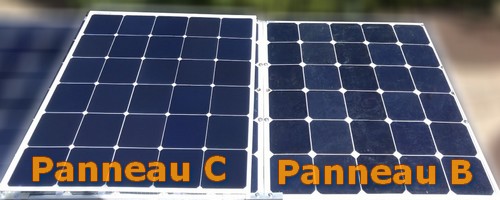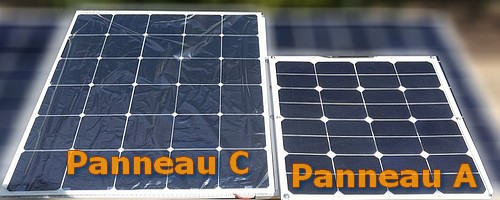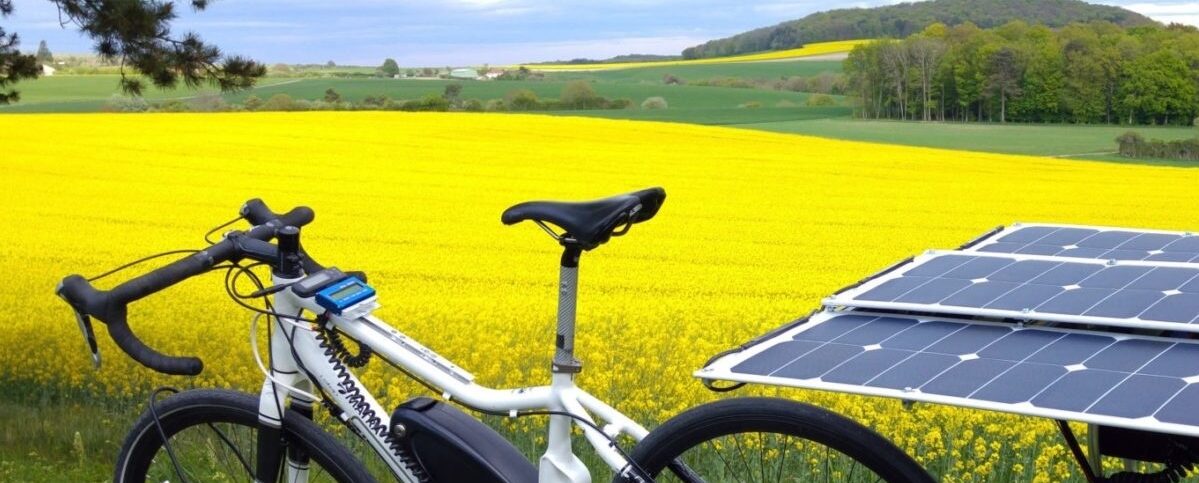 After several days of rain, the Sun came back! It is slightly veed but no matter: I was too eager to test the solar panels received three days earlier! I compared them to the panels bought in 2017 and 2018. Although this test has no scientific value, the observations have seemed interesting enough to be published.
After several days of rain, the Sun came back! It is slightly veed but no matter: I was too eager to test the solar panels received three days earlier! I compared them to the panels bought in 2017 and 2018. Although this test has no scientific value, the observations have seemed interesting enough to be published.
Test panels

|
Panel A specified power: 50Wc nominal number of cells: 4 x 4 = 16 cell manufacturer: unspecified cell class: not specified provenance: purchase from a reputable reseller on internet price: 2 x €142 = €284 for 100Wc in 2017 |
 |
Panel B specified power: 100Wc nominal number of cells: 5 x 6 = 30 cell manufacturer: unspecified cell class: class C (visible defects) provenance: purchase on a famous auction website price: €135 in 2018 |
 |
Panel C specified power: 110Wc nominal number of cells: 5 x 6 = 30 cells: SunPower™ Maxeon cell class: class A provenance: purchase from Linksolar manufacturer price: €350 (~ 395 USD) in 2019 |
Measuring the instantaneous power of the panels
Not having a solar energy measuring device, it was not possible for me to measure the actual performance of each Panel. So I chose to measure the instantaneous power of the panels with wattmeters, in the sunshine conditions of the moment. And I compared 2 to 2 the panels connected each to an identical charge regulator charging the same battery.
Measured power with panels B and C 

Measured power with panels A and C 

Reservations about the test protocol
Various elements could impact the outcome of the measures and their analysis:
-
- difference in the years of panel manufacturing, in a context of steady progression of cell performance;
- difference in State of obsolescence and use of panels: Panel C totally new, Panel B having travelled several thousand km (vibrations + shocks), Panel A of 2017 never used and stored;
- calibration difference of non-certified wattmeters;
- measurements made by veted Sun (repeat the test in other conditions of sunshine).
However, these elements can not fundamentally call into question the results obtained.
Calculations and results
The C Panel being the most powerful, I took it as a reference. I calculated the ratio of the power produced by Panel A or B to the power produced by Panel C. The table above shows the relative efficiency of panels A and B in reference to Panel C, which therefore has an efficiency of 100%. Pushing the reflection further, I imagined an increase in the surface of panels A or B to get the same power as the C Panel. I then calculated the cost in corresponding A or B panels, and the corresponding panel surface.

NB: I took into account the difference in the number of cells (Panel A: 16 cells, panels B and C: 30 cells).
When observing this table, the following remarks can be issued:
Real power:
- panels A and B have almost identical power while panel A is 2 times more expensive than panel B;
- the power of panel C is almost double that of panels A and B.
Price to get the same real power:
- at equal power, panel A is 71% more expensive than panel C;
- at equal power, panel B is 21% cheaper than panel C.
Surface to achieve the same real power:
- at equal power, panels A and B occupy 90% more surface area than panel C.
Personal notes
Objective and subjective criteria had guided my purchases:
- in 2017, I totally discovered the universe of the solar panel, it had reassured me to buy at a large recognized website, the many exchanges by phone and email had given me confidence.
- in 2018, I wanted to experiment with a low-spread panel format (6×5 = 30 cells) and I had found on the market only these panels at low prices.
- in 2019, I had the urge and the opportunity to invest in quality equipment, to increase the performance of my bike.
Conclusions
- A high price is not always a guarantee of the performance of the equipment.
- Lower yield panels (50%) have a strong impact on the solar bike: less autonomy or increased dimensions. In both cases, this will degrade the rider’s comfort and safety.
- A higher expense for quality equipment ultimately represents an economy: the value for money is much better.
Not to mention the other benefits: autonomy, maneuverability, performance…
Views: 272
